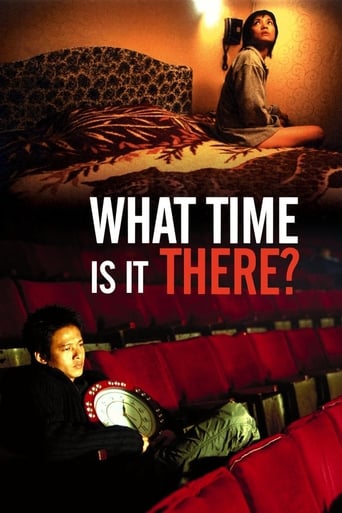mjuice
Ugh.This is one of the least good movies I've seen in a long time, and I've seen some really bad ones. This one, however, is bad in a rather different way. This is the "story" of a guy who sells a girl his watch and somehow feels connected to her as she leaves for Paris. He goes around setting clocks to Paris time. He... oh wait, that's pretty much all he does in terms of thinking about her. I thought this was some huge romantic thing? As for her... she barely thinks about him, but I guess maybe she does though all we ever see is her doing random things in Paris with other people. Nearly every scene was too slow. I realize the movie is supposed to be about time, but if you want to make the point that cutting from one scene to another leaves out all the slow time in the middle, fine, but DON'T do it for the whole movie. I nearly wanted to cry after the first 15 minutes (and 2 scenes).The only halfway decent part of this movie is the performance by Yi-Ching Lu as the boy's mother, who is greiving over her husband's death in many real and interesting ways, which leads to a few very poignant scenes. Unfortunately, there were far too many scenes without her in it, and it got aggravating.
herb2000
"Terrible" has a reasonably good handle on describing the pace of this movie. I watch it and did found its lack of dialogue disturbing at first but had a level of curiosity high enough to enjoy it. It is a conversation piece since how many movies can you discuss where you basically remember each and every line (there are so few).The movie leaves enough open, and sometimes pointless, scenes to leave a great amount of room for interpretation. Reading the Director's comments helped a bit and I feel a great need to watch Truffaut's "400 Blows" given the numerous references in the movie and commentary. Then again there is enough that I have chalked up certain scenes to being meaningless. My take - Death happens, Celebrate the living.
pjrdct
(...continued from Part1)The most significant encounter, of course, was with the young woman heading to Paris, the "there" in What Time is it There? I believe she is a ghost and her contact with Xiao Kang and the exchange of the watch is somehow responsible for his peculiar behavior and experiences. If France can be taken to be a metaphor for death or the "otherworld," then Xiao Kang's strange fascination with all things French can be seen as his desire to understand his father's death. Viewing an old French film becomes a way to catch a glimpse of the "otherworld" where his father might be. Drinking French wine may be yet another method to reach the trance-like state that facilitates communication with his father.Tsai explores the various avenues of communication between the living and the dead. He shows the Buddhist rituals, the food offerings, burning ghost money, etc., intended to establish contact or at least help the deceased. He shows how non-spiritual ways such as memories, mementos, and imagination are all employed to keep that person "alive." Xiao Kang's tampering with time is his idiosyncratic approach. We even see him using an antenna, a communication device, to adjust a giant clock. In return for these efforts the deceased is expected to communicate to the living by way of signs or in dreams. We see Xiao Kang crying in his sleep-perhaps a visitation by his father in such a dream. His mother desperately looks for signs of her husband's return, even if it's only as a cockroach or a fish.Tsai points out in this film that contacting the dead is a difficult and frustrating endeavor only leading to more suffering. He adds that the dead are having an equally difficult and frustrating time communicating with us. Moreover, they are having trouble adjusting to their new reality-at least until reincarnation occurs. The young woman in Paris is seen wandering aimlessly and communicating only with difficulty with the Parisians. Her aborted telephone calls can be seen as attempts to contact the living, probably loved ones. There is evidence that these loved ones are somehow getting through to her; the snack plate she nibbles on in her hotel room uncannily resembles food offerings to the dead. The overwhelming feeling we get from her experience is that of frustration and profound sadness. Her exhaustion and eventual collapse may indicate her resigned acceptance of death.Xiao Kang's father though appears to be farther along in the process. He seems calm and sure in his actions. His struggle appears over. His walking toward the Ferris wheel is deliberate, reincarnation imminent. The film ends here on this hopeful note.What Time is it There? has much in common with Tsai Ming-Liang's earlier films. He again explores the difficulty in communicating or establishing connections with others. Only this time he included the dead in his universe and in the process created a rich and mysterious work. Despite an elliptical and metaphoric structure, and despite an imperfect understanding of Buddhist philosophy, upon reflection the meaning of What Time is it There? emerges slowly but surely.
Lagomorph
It wasn't a bad film. Not by any means. It was very well crafted, beautifully filmed, and managed to impart a powerful mood with artistry and precision. Now, I'm not a lightweight about slow-moving films. But after an hour of this film I was about to chew my own leg off to try and escape. You reach this point where you see the female lead step on one end of a LOOONG escalator, and you think to yourself, "I'm going to have to watch her go the length of that whole damn escalator, aren't I?" And yes, yes, you do.



